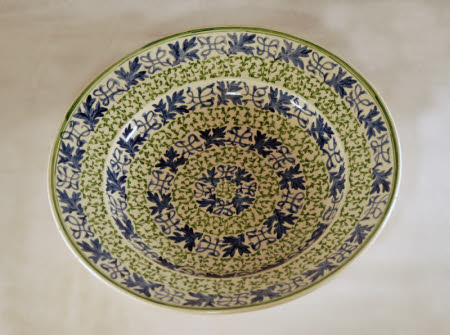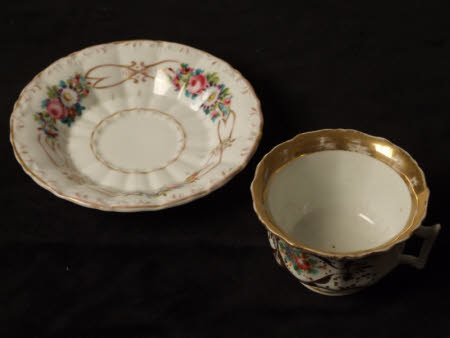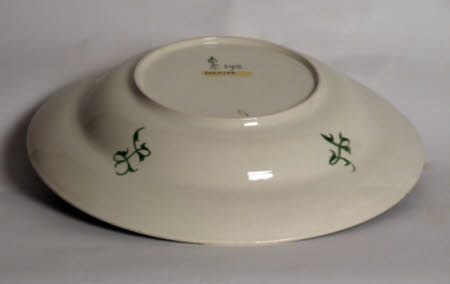A large hand-painted charger
Louise Powell (1882-1956)
Category
Ceramics
Date
1914
Materials
Ceramic
Measurements
16.375 ins (dia)
Order this imageCollection
Shaw's Corner, Hertfordshire
NT 1274567
Caption
Ada Louise Powell was a talented painter, calligrapher and embroiderer. She is best known for the intricate, hand-painted ceramics she produced as an independent artist working with pottery manufacturer Josiah Wedgwood & Sons. Powell was from a creative family and ceramics were in her blood. Her grandfather Emile Lessore (1805–76) trained at the Sèvres porcelain manufactory in France, before moving to England and joining Minton, later becoming a design consultant for Wedgwood. Her father, Jules, and her sister Elaine Thérèse also painted Wedgwood ceramics. Powell trained in calligraphy and illumination at the Central School of Arts and Crafts in London. An important early commission was the remarkable work she undertook to complete an unfinished illuminated manuscript translation of Virgil’s Aeneid by William Morris (1834–96). The expression, line control, rich level of detail and use of jewel-like colour that she learned through her training translated beautifully into ceramic painting. Following her marriage to Alfred Powell (1865–1960), Louise began to focus on ceramics. From their studio in Red Lion Square, London, the Powells designed and decorated Wedgwood blanks (undecorated pots), which were sent back to the company factory in Etruria, Stoke-on-Trent, to be fired and sold, often through the London retailer and glassmakers James Powell & Sons. The Powells regularly visited Wedgwood, where they studied the historic pattern books and trained the factory’s decorators in hand-painting on earthenware (at the time, ceramics were decorated mostly by printing). The Powells’ relationship with Wedgwood lasted for 40 years and their work firmly re-established the company’s reputation for artistry and traditional craftsmanship. Many of the artists they nurtured, such as Millicent Taplin and Star Wedgwood, went on to enjoy long and distinguished careers in the Potteries. The Powells were good friends with George Bernard Shaw and his wife, Charlotte; a personalised lustre-decorated beaker in the collection at Shaw’s Corner must have been created by Louise as a personal commission or gift (NT 1274575). A photograph of Shaw’s desk shows the beaker behind his inkstand, filled with pens and pencils. Charlotte also owned a washstand painted by Louise Powell.
Summary
Charger, earthenware, decorated by Louise Powell (1882-1956) on a Wedgwood blank, 1914; blue leaf and scrollwork bands alternating with stems of small green leaves in intersecting Cs. Painted monogram ‘LP 592’.
Full description
A large hand-painted charger decorated by Louise Powell (1882-1956). Louise studied Arts and Crafts embroidery and calligraphy, and her husband Alfred Powell (1865-1960) was an Arts and Crafts architect and designer. Together Alfred and Louise Powell became celebrated as pottery designers for Wedgwood, particularly for their achievements in the revival of the art of hand-painting on pottery. The Shaws purchased numerous pieces of their work throughout their marriage, and regarded the couple as close friends. The Powells and their assistants decorated mass-produced blanks with William Morris-inspired motifs of stylised flowers and animals, which would be sent back to the Wedgwood factory for firing after decoration. The pieces owned by the Shaws were the expensive ceramics hand-painted by either Alfred or Louise Powell themselves (not those produced commercially by their studio assistants). Shaw became interested in Louise’s artistic background given that she had worked as a calligrapher on two of William Morris’s illuminated manuscripts. Charlotte’s diaries reveal the two couples meeting regularly at Adelphi Terrace, and the Shaws visiting the Powells in Gloucestershire. Shaw maintained an interest in ceramics and the firm of Wedgwood throughout his life, and in 1930 he visited Stoke to attend the Wedgwood Bicentenary Pageant. (Alice McEwan, 2020)
Provenance
The Shaw Collection. The house and contents were bequeathed to the National Trust by George Bernard Shaw in 1950, together with Shaw's photographic archive.
Marks and inscriptions
On the base - Decorators mark 'LP', '592' and WEDGWOOD stamp.
Makers and roles
Louise Powell (1882-1956), ceramicist Wedgwood, porcelain manufacturer
References
Conroy, Rachel, Women Artists and Designers at the National Trust, 2025, pp. 176-7; p. 259


